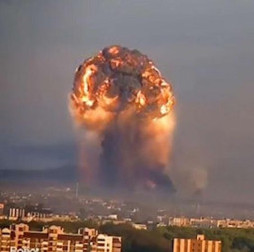The comic logic of NATO's bureaucracy naming military maneuvers Steadfast Jazz, paradoxically, affected the exercise.
The current NATO Exercise Steadfast Jazz became the largest one since the Cold War. According to the scenario, a multinational group of troops was deployed in the territory of Poland and the Baltic States in order to conduct a large-scale strategic offensive in the east.
Despite NATO Secretary General Rasmussen's statement that the maneuvers have nothing to do with Russia, in this country the exercise is regarded as a show of force in response to September Russian-Belarusian anti-terrorist exercises Zapad-2013.
But there is another important point. Steadfast Jazz 2013 scenario sets out meeting a large-scale cyber attack on NATO countries. So a prominent role in preparing and conducting the exercise is given to NATO Cooperative Cyber Defence Centre of Excellence (NATO CCD COE), with responsibilities for monitoring and prevention of aggression against NATO in cyberspace.
It is worth mentioning that the deployment of this structure in the capital of Estonia was recognition of the country's merits in the implementation of e-Government and encouraging its commitment to lead in this area. On the other hand, it was associated with the events of spring 2007, when, after the removal of the monument to Soviet soldiers, Estonia faced not only mass street unrest among Russian-speaking citizens, but also hacker attacks on government sites, which were attributed to the Russian security services.
Just a week before the start of the current exercise Latvian Minister of Justice Janis Bordans made a proposal to dismantle the monument to the soldiers of the Red Army, now in Riga. Naturally, this caused a predictable outrage of the Russian-speaking community of the Baltic countries who saw echoes of the events in Tallinn in Bordans's statement.
The question is why the provocative statement was made precisely now and how it is related to NATO Secretary General's arrival in the Latvian capital.
The obvious goal of the demarche was to cause a public outcry, to provoke a conflict between Latvians and Russian citizens of Latvia, street unrest, and perhaps attempts to hack government websites by hackers-activists to get a formal reason for the closure of Russian language media, as was the case in Estonia in 2007. And besides, to play along and give the Tallinn Center for Cyber Defense the opportunity to express itself in a real business, rehearse the information blockade of Russian-speaking citizens who are treated as a fifth column by the authorities of the Baltic countries.
At the same time the broadcasts of the largest Russian-language First Baltic Channel were suspended in Lithuania by court order for three months. Apparently, the NATO command's strategic plans include informational isolation of Russian speaking population, including EU full citizens, in case of aggravation of relations with Russia. It is very likely that, in addition to the blockade of the Kaliningrad region, this component was a subject to work out in the current exercise.
However, at a certain stage the process was out of control and everything did not go according the script. It began with the fact that on the eve of the exercise a group of Ukrainian hackers struck into the heart of NATO's cyber security. November 1, Anonymous Ukraine group saver appeared instead of the website of the Estonian Ministry of Defence. The group is known by hacking a series of news portals and websites of state structures of Ukraine, Poland, Russia and the EU.
Obviously, after that NATO cybersecurity officers activated their efforts to implement the plan of the exercise. Morning of November 5 technical services of hundreds of NATO countries' government websites (mainly the various defence agencies of the Baltic States and Poland) received formidable notifications of non-compliance with the NATO security standards from NATO CCD COE. In some cases, the home pages displayed the notification of suspension of their activities because of not being ready to hacker attacks which can follow during the Exercise Steadfast Jazz 2013. On entry to the sites users could see the message "Security policy of the website does not meet the requirements of NATO Cooperative Cyber Defence Centre of Excellence."
Among them were the websites of Latvian Defence Ministry, a number of resources of military agencies of Estonia, Lithuania and Poland. The Black Mark from Tallinn was also given to the websites of the Ukrainian government. Thus, the websites of General Prosecutor Office, Military Medical Directorate of the Security Service of Ukraine, the State Foundation for Basic Research, etc. did not meet the NATO standards.
The first reaction of Ukrainian Internet community was bewilderment. It was puzzled why NATO decided to close the websites of the state not even included in its structure, and whether it violates the accepted international norms in the field of cyber security. In some cases, the Alliance was even accused of deliberately striking the Ukrainian government network infrastructure that is aggression and the cause of the war according to the rules of NATO.
However, a different version seems more credible. It was reported earlier that Kiev had sent a company of Marines to participate in NATO exercises. Apparently, Ukraine did not stop there, and the websites of the Ukrainian offices were involved in the activities undertaken by NATO Cooperative Cyber Defence Centre of Excellence within the framework of the joint training on the exercise scenario.
November 6 NATO Cyber Defence Centre spokeswoman Kristiina Pennar officially declared that NATO intelligence was not involved in the incident, saying it was the activities of "unidentified hackers." The Ukrainian side did not comment on the incident.
Of course, the information on the websites could possibly appear by mistake. It is also possible that the Cyber Defence Centre was really a victim of the draw by the bothersome Anonymous Ukraine. And yet unfolding vigorous activity in cyberspace during the exercise gives an extra reason to remember Snowden's revelations and the ubiquitous hand of "big brother".









